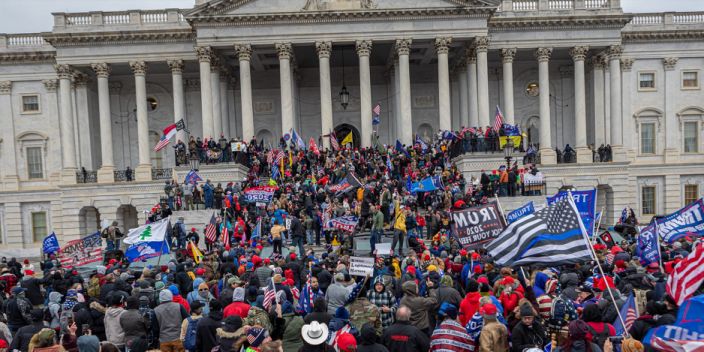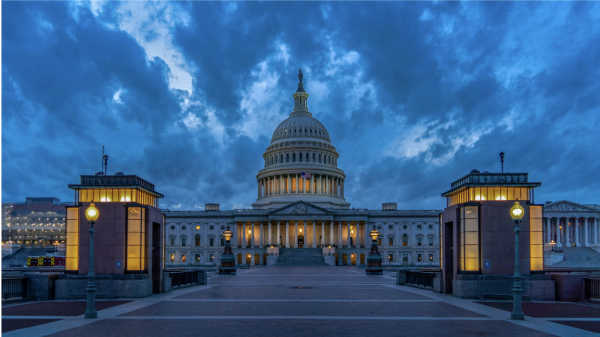Civil Rights Protections, Freedom of Speech, and the Display of the Confederate Flag: How Far Do Our Freedoms Go?
The Capitol Insurrection was full of hate – but does the law protect it?
Photo courtesy Michael Nigro
TW: white supremacy, Nazism
In the incipience of a year with high expectations, Donald Trump did not fail to disappoint. On January 6th, 2021, he rallied his supporters from across the country for the March to Save America, insisting that he would walk with them from President’s Park to the Capitol building in Washington D.C. Two days prior, a permit was granted for 30,000 people to gather from 9:00-5:00 PM. But by the early afternoon, a protest turned into a riot. The president’s supporters infiltrated the capitol with a sundry mix of symbols and flags, destroying government property and jeopardizing the lives of the officials inside. It was a breeding ground for far right extremism: there were swastikas, Confederate flags, and “Keep America Great’ gear, all in one place.
Like its 2021 counterpart, the 2017 Unite the Right Rally in Charlottesville, Virginia, was an expression of American freedoms. This rally was centered on white supremacism: the idea that white people are superior to all other races and should dominate them. It revolved around hate and pride, a toxic cocktail that spurred violence.
The symbols shown off by the attendees of both rallies undoubtedly held racist and hateful connotations. Though until the Capitol was broken into 2021, these gatherings were simply an expression of freedom of speech and freedom of assembly: two of our fundamental rights as American people.
Now, rewind, 50 years. It’s 1964 and the Civil Rights Act was just passed, (in short) outlawing discrimination based on race, color, origin, sex, religion, and later sexual orientation and gender identity. This was a landmark act. Among other things, it made voting easier for minorities, barred businesses from refusing to serve based on the above characteristics, and desegregated public facilities and schools. Although not all of these were accomplished immediately (and still haven’t been today), it represented a move towards liberty and justice for all.
There is an undeniable conflict between the expressions of freedom of speech we see at these riots and the Civil Rights Act, but a constitutional right and an act have different weights. This act can clash with a right. A right is the law of the land. If we begin to limit free speech, it would be an opening to censorship and an infringement of our constitutional right.
The line must be drawn at tangible, explicit actions of discrimination. This is what the Civil Rights Act aimed to curb. It was not a hate speech law. The government can limit these symbols, control the hateful sentiments, and educate the public about their gravity, but the displays we saw at the Capitol do not violate the Civil Rights Act.
Yet, this conclusion is infuriating. Hate speech is a disease, one that has plagued social media and incited violence. Our empathetic, justice-loving hearts are conflicted. On one hand, we know hate speech to be harmful, but on another, freedom of speech is what allows Dave Chappelle to perform a 10-minute monologue on SNL with “I hate white people” as the central theme.
Freedom of speech guarantees the right to say, but not to be heard. This is where the policies of social media come in. In early October 2020, Instagram announced that they would automatically be hiding “potentially offensive” content, a response to the critiques on their handling of hate speech. Facebook, Instagram’s parent company, stated in August 2020 that they removed 22.5 million posts “containing hate speech” in the second quarter of the year, a 12.9 million increase from the first quarter. The public’s opinion was mixed. On the left, the companies were applauded then chastised for waiting so long. On the right, it was called censorship. News outlets like Fox News called it a stripping of rights, framing themselves as the victims. What they failed to see were the privileges private companies wield.
So how do we curb freedom of speech into speech that doesn’t jeopardize justice? Well, try Germany’s approach. Germany’s Nazi history during World War II made it a country of atrocities. On top of reparations for Jewish people and control over Nazi thought, the country needed a reformation. The minute the war ended, the Allied intended to remove all Nazi influence from the country in a proccess known as “denazification” (coined in Frederick Taylor’s 2011 book). Today, this manifests in the Volksverhetzung, a law preventing the incitement of violence against any “national, racial, religious group or group defined by their ethnic origins” or speech that “assaults the human dignity of others by insulting.” This law is often employed against Holocaust deniers. Germany also has a free speech law, the Grundgesetz, but the law protects any “non-outlawed” speech. The relationship between these two laws is intricate: in order to be tried for hate speech, it must “disturb public peace,” among other qualifications.
Germany’s laws surrounding freedom of speech and hate speech are not alien to our own, but their approach to Nazi symbolism and swastikas is a bit more intense. They are considered promotion for “anti-constitutional organizations,” and although they can be used for educational, artistic, or scientific purposes, it is illegal to post a picture on social media with them, display them publicly, or sell goods with them. Germany’s extreme precautions against this memorabilia are in response to the country’s history and the symbolic weight of it. While the Holocaust is vastly incomparable to the Civil War, doesn’t our struggle with the Confederate flag echo theirs with Nazi symbols?
To understand the weight of this symbol, we have to look at its history. Our modern Confederate flag originated as the battle flag of Robert E. Lee’s army of Northern Virginia. The flag quickly came to represent “the independence of a nation dedicated…to the defense and perpetuation of slavery,” according to the American Civil War Museum. It went on to become the symbol of Confederate Veteran groups like The United Confederate Veterans and the Sons of Confederate Veterans. A quick Google search will tell you that the latter still exists, flooded in coded language stating that “the preservation of liberty and freedom was the motivating factor in the South’s decision to fight the Second American Revolution” (SCV), and claiming themselves to be a “non-racial” and “non-political” organization.
The heritage versus hate discussion is as pertinent as it was a century ago. Many current displayers claim it’s Southern pride. Now, reexamine this in relation to the Capitol riots. According to the New York Times, the symbols displayed besides the Confederate flag included right-wing militias, the Proud Boys (notorious white sumpremacists), and QAnon. Every group seen represented a type of hate towards an entire group: a race, a sexuality, a political view, and more. It was not an event of Southern pride. It was an event of pride in hatred, a cry for the preservation of oppression. It was centered around denial of democratic progression.
To ban such symbols outright would be a Constitutional violation. However, what the government can do is regulate and educate. The German approach to Nazism walks the careful line of preserving freedom of speech and keeping people safe, and although the Confederate and Nazi flags have integral differences, both are the outgrowth of hate for another group. The Confederate flag may be seen as a symbol of Southern pride to some, but to those that it historically repressed, it’s a sign of assumed supremacy. Take an incident at a North Carolina high school in 2012, where the day after Cinco de Mayo, when many Mexican students came to school with Mexican flags, white students showed up with Confederate ones (Salon). On paper, the two symbols of nationalism may seem equal, but history tells all. Context matters.
The United States can take steps to acknowledge its racist history and become a more inhabitable place for Black citizens by limiting the Confederate flag — or at least, addressing its gravity in a public way. There’s beauty in our freedoms, but how much is being violated by, for example, outlawing the public display of the flag? Once again, our freedom of speech never promised the freedom to be heard. The regulation of hateful symbols, combined with a standardized education about the Civil War and the Confederate flag’s history, would help us move past it, instead of neglecting our history to a boiling point that exploded at the Capitol insurrection.
Sources
Taylor, Frederick (2011). Exorcising Hitler: The Occupation and Denazification of Germany. Bloomsbury Publishing.
www.dw.com/en/germanys-confusing-rules-on-swastikas-and-nazi-symbols/a-45063547
https://www.nytimes.com/2021/01/13/video/extremist-signs-symbols-capitol-riot.html
https://www.history.com/topics/black-history/civil-rights-act
https://abcnews.go.com/US/trump-allies-helped-plan-promote-rally-led-capitol/story?id=75119209
https://www.nytimes.com/2021/01/10/us/politics/capitol-siege-security.html
https://acwm.org/blog/myths-misunderstandings-confederate-flag/







